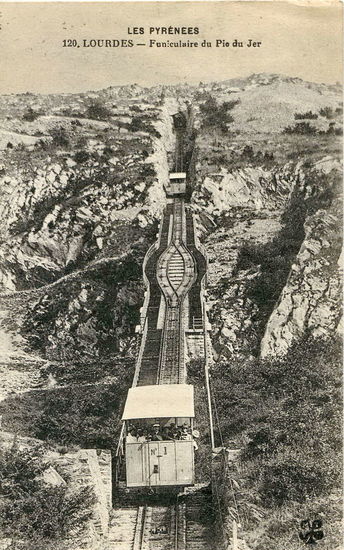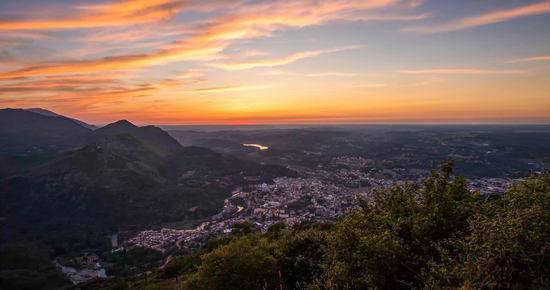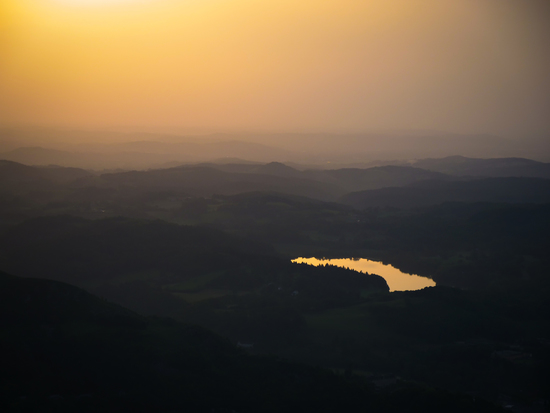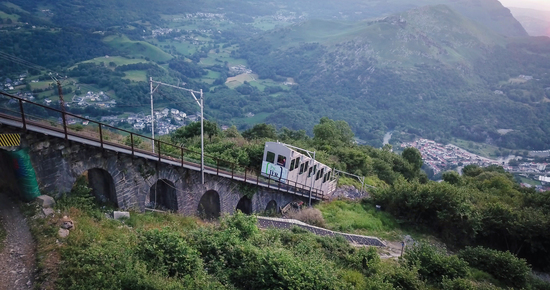History

History
After 1858, the year of the Virgin Mary's apparitions to Bernadette, a basilica was built by decision of the bishropic of Tarbe and began to attract great numbers of pilgrims to Lourdes.
In 1866, the date on which the railway arrived in Lourdes, the volume of pilgrims was continuing to rise and exploiting the tourism potential of Lourdes and its surrounding region became a priority; the idea of a funicular linking the summit of the Grand Jer to the base of Lourdes was given the go-ahead.
The funicular, designed by the engineer Chambrelent, was one of the first to be built in France. Work began in August 1898 and ended 15 months later in December 1899.
The speed with which the work was carried out was thanks to an overhead cable which transported up to 50 tonnes of stones every day from a quarry in the Petit Pic du Jer. All the rubble from the tunnels and the trench was removed with wheelbarrows or shovels and put back into the hillside. The normal load of dynamite was doubled in order to save on labour costs.
Rubble could thus be blasted out on both sides with no human effort. The funicular was put into operation in May 1900 and inaugurated in June of the same year. At that time, the open cars would make passengers dizzy, before then being changed in the 1930s.
Today's cars date from that period. It was also in 1900 that the famous metal cross which is visible from Lourdes was installed on the summit of the Pic du Jer. In the 1930s, two cable cars - one for Béout and the other serving Pibeste - were also built and competed with the funicular. Nowadays, only the Pic du Jer funicular remains in operation.
The legend of the mountain

The legend of the mountain
God the Father, creating the world, was about to finish his work by building the Pyrenees, when he noticed that he had some material left over. Where should he put it ? The Pyrenees had been so well designed: should he risk compromising their harmony with a misguided addition ? Furthermore, wasn't it best to avoid setting men the bad example of losing something ?
The Creator made a quick decision. With a final stroke using his last remaining materials, he placed - at the bottom of the foothills bordering the plain - two small peaks which were both pleasant and welcoming.
One, the Petit Jer, arose from the simple splash of a trowel exhausted after six days' work. The other, the Grand Jer, rises majestically to an altitude of 1000 metres and, from its three-point summit, offers panoramic views over a 50km horizon.
The legend of the plain

The legend of the plain
When the Gave, the deep-voiced giant of the mountains, who was feared for his agility and fast reactions, decided to go down to the plain, he came across a small and stocky dwarf with smooth skin and a frail voice who put up a long fight.
The relentless battle took place at the very foot of the Grand Jer and ended in victory for the Gave. However, the dwarf, retreating furiously from the wild-bearded victor, was determined to show his scorn and spat twice in the giant's face.
Thus were born (from the two globules of spit) two ponds, the Grand You and the Petit You, which can be seen from the base itself of the Pic du Jer.
The legend of the funicular

The legend of the funicular
Roland, the celebrated paladin (military leader) and nephew of Charlemagne had spent a good while fighting the ferocious Saracens who had taken refuge in the mountains overlooking the valley of Lourdes.
The force with which he pressed down on his foot and knee was such that, according to some writers, he created two deep hollows which became the Grand You and Petit You ponds. He soon decided it would be useful to get a clearer view of his progress against the non-believers.
He therefore climbed the peak of the Grand Jer. Realising that the battle was not over yet, he brandished his sword with almighty force that was sure to strike fear into the heart of his enemies. In doing so he cut a tremendous gap into the neighbouring mountain, which has ever since been known as "Roland's breach".
He was extremely thirsty but felt that he should not leave his position to find a drink. So he took Durandal by its blade, held it to the ground and lowered it towards the plain.
His fellow soldiers hooked a large barrel of water drawn from the Gave to the sword's guard.
Roland effortlessly drew the water up towards him by sliding this primitive wagon over the earth, and this first railway from the Carolingian epic tale provides the legendary origins of our funicular railway.
